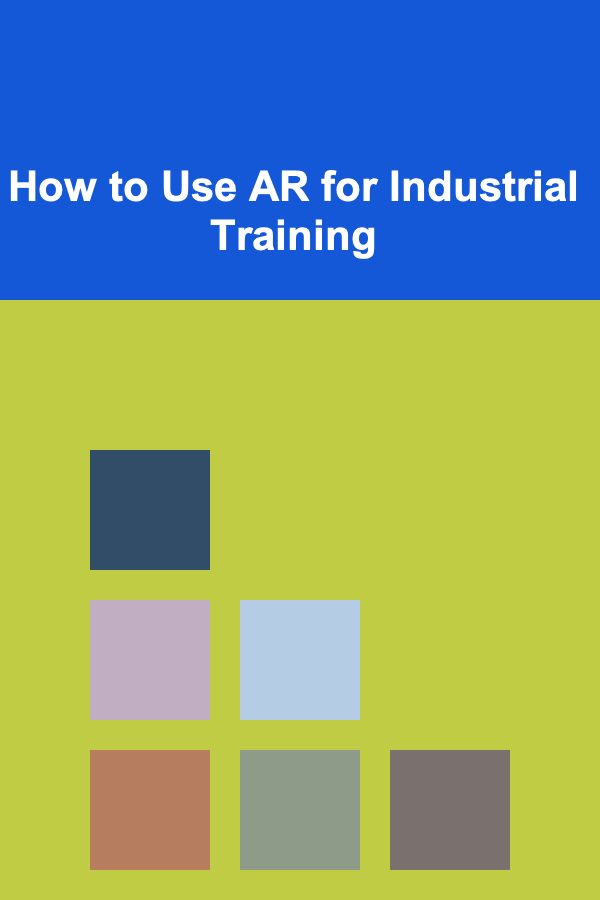
How to Use AR for Industrial Training
ebook include PDF & Audio bundle (Micro Guide)
$12.99$8.99
Limited Time Offer! Order within the next:

Augmented Reality (AR) has emerged as a transformative technology, blending digital elements with the real world. Its potential for various industries, including manufacturing, healthcare, education, and retail, is enormous. However, one area where AR is particularly making waves is in industrial training. By creating immersive, interactive learning experiences, AR can enhance the effectiveness of training programs, reduce costs, and improve safety in industrial environments.
This article explores how AR can be used for industrial training, covering the technology behind AR, its benefits, implementation strategies, and real-world examples. By the end of this article, you'll understand how AR can revolutionize industrial training, making it more efficient, engaging, and cost-effective.
Understanding Augmented Reality (AR)
Before diving into its applications in industrial training, it's essential to understand what AR is and how it works.
What is Augmented Reality?
AR refers to a technology that overlays digital content (such as images, sounds, or data) onto the real world in real-time. Unlike Virtual Reality (VR), which creates a completely immersive environment, AR enhances the physical world with virtual elements. These elements are often displayed on devices like smartphones, tablets, or specialized AR glasses, allowing users to interact with both the real and virtual worlds simultaneously.
AR technology relies on several components:
- Sensors: These detect and track the user's position and movement, often through cameras, GPS, accelerometers, or gyroscopes.
- Processing: This component processes the data captured by sensors to integrate digital content with the physical world.
- Displays: AR content is typically displayed through screens such as smartphones, smart glasses, or heads-up displays.
- Software: AR applications rely on sophisticated software to generate and manage the augmented elements in the real world.
In industrial training, AR typically overlays instructional content, like 3D models, step-by-step guides, or interactive simulations, on real-world machinery or environments, enhancing the learning experience.
Benefits of Using AR for Industrial Training
The integration of AR in industrial training offers numerous advantages that traditional training methods cannot match. Here are some of the key benefits:
1. Improved Learning Retention
AR enhances learning by making training more interactive and engaging. By allowing learners to visualize complex processes and interact with real-time simulations, AR helps improve information retention. Studies show that immersive learning experiences lead to better comprehension and long-term memory compared to passive learning methods, such as reading manuals or watching videos.
2. Reduced Training Costs
Traditional industrial training often involves expensive resources, such as physical equipment, instructors, and time-consuming procedures. AR training programs, on the other hand, can be delivered on cost-effective devices like smartphones or AR glasses, significantly reducing the need for physical infrastructure. Additionally, AR can simulate hazardous or complex environments without the need for physical materials or environments, reducing costs associated with real-world training setups.
3. Enhanced Safety
Industrial environments, especially in manufacturing and construction, often present significant safety risks. AR training allows workers to practice handling machinery, navigating dangerous environments, or responding to emergency situations in a controlled, risk-free setting. This helps workers gain confidence and proficiency without exposure to actual hazards, improving overall safety on the job.
4. Remote Assistance and Collaboration
AR can facilitate remote assistance and collaboration, enabling workers to receive real-time guidance from experts, regardless of their physical location. Using AR glasses or apps, an expert can remotely guide a worker through complex procedures by overlaying instructions or annotations on the worker's field of view. This capability can significantly reduce downtime, especially when on-site experts are unavailable.
5. Scalability and Accessibility
AR training can be easily scaled across multiple locations and accessible to a large number of employees. Once an AR training program is developed, it can be replicated and rolled out across different factories, plants, or sites, ensuring consistency in training and improving overall workforce competence. Moreover, AR enables on-the-job training, where employees can learn as they perform their tasks, making it easier to integrate training into daily operations.
6. Faster Skill Acquisition
In traditional industrial training, learning may involve reading manuals, attending classroom sessions, or performing repetitive tasks to gain experience. AR accelerates this process by providing immediate feedback and hands-on practice in a safe and controlled environment. With AR, workers can practice skills repeatedly and in context, leading to faster skill acquisition and mastery.
How AR is Used in Industrial Training
1. Virtual Training Simulations
AR can create realistic simulations of industrial processes, allowing workers to practice tasks in a virtual environment. For example, in the automotive industry, AR can simulate the assembly of parts in a vehicle, enabling trainees to learn the process without needing to be in a live production environment. These simulations can replicate complex tasks, such as welding, assembly, or equipment operation, and allow workers to practice until they are proficient.
2. Step-by-Step Guidance and Instructions
One of the most common uses of AR in industrial training is providing step-by-step guidance to workers. By wearing AR glasses or using a mobile device, workers can see overlaid instructions or visual cues that guide them through a specific task. For instance, an AR application could show workers how to operate machinery, troubleshoot an issue, or assemble a component, with virtual arrows or highlighting that point out the exact parts they need to focus on.
3. Interactive 3D Models
AR can bring 3D models of machines, equipment, or entire industrial systems to life. Workers can interact with these models to learn how different components work and understand complex systems. For example, in the oil and gas industry, AR can display a 3D visualization of an oil rig, showing various components, pipes, and systems. This enables trainees to explore the inner workings of equipment in a hands-on, engaging way.
4. Maintenance and Troubleshooting Training
AR is particularly useful for maintenance and troubleshooting training. Trainees can wear AR glasses or use mobile devices to get real-time instructions when diagnosing issues with machines. AR can overlay information such as diagnostic data, repair procedures, or even highlight damaged components on the machine itself. This approach not only accelerates the learning process but also helps workers become more adept at handling real-world problems.
5. Safety and Emergency Protocols
In hazardous industrial environments, safety training is essential. AR can simulate emergency situations, allowing workers to practice responding to emergencies such as fires, electrical failures, or chemical spills. Through immersive simulations, workers can practice their reactions without risking their safety. AR can also provide real-time safety reminders, such as proper handling techniques or hazard warnings, during daily operations.
6. Remote Assistance and Expert Support
In industries like manufacturing, where downtime can be costly, AR enables remote assistance. Workers can connect with remote experts who can guide them through difficult tasks by overlaying annotations or instructions on the worker's view of the equipment. This remote support helps ensure that workers can continue their tasks without needing to wait for on-site experts, improving productivity and reducing delays.
Real-World Examples of AR in Industrial Training
1. Porsche's AR Training Program
Porsche, the German automotive manufacturer, has integrated AR into its training programs to teach employees how to repair and maintain vehicles. Through AR glasses, technicians can view detailed schematics and step-by-step instructions while working on a car. This allows for more accurate repairs and faster completion times, reducing the need for lengthy training periods.
2. General Electric (GE) and AR for Maintenance Training
General Electric (GE) has used AR technology to train employees in maintenance and repair tasks across various industries, including aviation and energy. By using AR glasses, technicians can access real-time data and instructional overlays while working on complex machinery like jet engines or power turbines. This approach has improved training efficiency and helped GE reduce downtime in its operations.
3. Boeing's Use of AR for Wiring Harness Assembly
Boeing has adopted AR technology to improve the wiring harness assembly process in aircraft manufacturing. By using AR glasses, assembly workers receive step-by-step instructions overlaid onto their field of view, ensuring that wiring is correctly installed without the need for lengthy manuals. This method has reduced the time required for assembly and decreased the potential for errors, ultimately leading to faster production times and lower costs.
4. Siemens and AR for Industrial Equipment Training
Siemens, a global leader in industrial automation, has implemented AR training for its employees in various manufacturing sectors. The company uses AR to simulate the operation of complex machinery, allowing workers to interact with 3D models and practice troubleshooting. Siemens also uses AR for safety training, helping employees understand hazardous situations and emergency procedures without the need for real-world exposure to danger.
Challenges and Considerations
While AR presents significant benefits for industrial training, there are challenges and considerations to keep in mind:
1. High Initial Investment
Implementing AR technology can be expensive, particularly for small or mid-sized companies. The cost of AR headsets, software development, and infrastructure can be prohibitive. However, as AR technology continues to mature and become more accessible, the cost is expected to decrease over time.
2. Technological Limitations
Despite its promise, AR is still evolving, and some technological limitations remain. Issues such as battery life, the accuracy of tracking, and the complexity of creating realistic simulations can impact the effectiveness of AR training. These challenges need to be addressed to ensure that AR becomes a mainstream solution for industrial training.
3. Employee Adaptation
Not all workers may be familiar or comfortable with AR technology, especially older employees or those who are not tech-savvy. Proper training and gradual integration of AR into existing training programs are essential to ensure that employees can effectively use AR systems.
4. Content Development
Developing high-quality AR training content requires expertise in both the industrial domain and AR technology. Companies may need to invest in specialized content creation or partner with AR developers to produce effective training materials.
Conclusion
Augmented Reality is reshaping the future of industrial training by providing more engaging, efficient, and cost-effective learning experiences. By offering immersive simulations, step-by-step guidance, and real-time support, AR enhances employee performance, reduces costs, and improves safety. As technology continues to evolve, we can expect AR to become an even more integral part of industrial training programs, benefiting both workers and employers alike.
The future of industrial training is here, and it's augmented.
Reading More From Our Other Websites
- [Organization Tip 101] How to Use Labels Effectively in Your Home Organization
- [Organization Tip 101] How to Organize Your Favorite Board Games for Easy Access
- [Toy Making Tip 101] Best Fabric Scrap Toy Making: Upcycling Fabrics into Adorable Plushies and Sensory Toys
- [Home Holiday Decoration 101] How to Make Your First Christmas in a New Home Special
- [Personal Care Tips 101] How to Develop a Nail Care Routine That Lasts All Week
- [Needle Felting Tip 101] How to Craft Hyper‑Realistic Feathered Birds Using Advanced Needle Felting Techniques
- [Home Budget Decorating 101] How to Style Your Sofa on a Shoestring: Budget-Friendly Decorating with Blankets and Throws Hacks
- [Home Budget Decorating 101] How to Create a Functional Yet Stylish Kitchen on a Budget
- [Home Security 101] How to Secure Your Home When You Have Children or Pets
- [Stamp Making Tip 101] From Hobby to Handcraft: Mastering the Art of Stamp Making

Exploring Passive Income Ideas with Deep Learning Models
Read More
How to Incorporate Pull-Out Shelves for Convenience
Read More
How to Set Up a Holiday Photo Wall to Capture Seasonal Memories
Read More
How to Store Holiday Decorations Without Cluttering Your Home
Read More
How to Use Wall Decals for Quick and Affordable Home Updates
Read More
How To Calibrate Your Extrusion Settings
Read MoreOther Products

Exploring Passive Income Ideas with Deep Learning Models
Read More
How to Incorporate Pull-Out Shelves for Convenience
Read More
How to Set Up a Holiday Photo Wall to Capture Seasonal Memories
Read More
How to Store Holiday Decorations Without Cluttering Your Home
Read More
How to Use Wall Decals for Quick and Affordable Home Updates
Read More